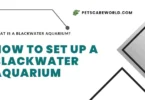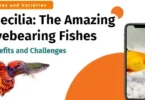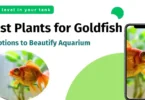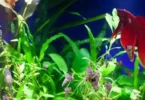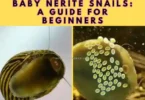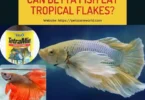Cherry shrimp are one of the most popular freshwater shrimp in the aquarium. They are easy to care for, breed well, and add a splash of color to any tank. But what do cherry shrimp eat, and how can you provide them with a balanced and varied diet? In this article, we will answer these questions and more. We will also cover:
- The natural diet of cherry shrimp in the wild
- The best foods for cherry shrimp in captivity
- How often and how much to feed cherry shrimp
- The benefits of feeding cherry shrimp algae and live foods
- The common problems and mistakes to avoid when feeding cherry shrimp
By the end of this article, you will have a clear understanding of what to feed cherry shrimp and how to keep them healthy and happy.
The Natural Diet of Cherry Shrimp in the Wild

Cherry shrimp are native to Taiwan, where they live in streams and ponds with plenty of plants and rocks. They are omnivorous scavengers, meaning they eat both plant and animal matter. In the wild, cherry shrimp feed on:
- Algae and biofilm that grow on plants and rocks
- Detritus and organic waste that fall to the bottom of the water
- Microorganisms and small invertebrates that live in the substrate
- Plant matter and fruits that drop into the water from nearby vegetation
Cherry shrimp are not picky eaters and will consume anything that they can find and fit in their mouths. They use their mouthparts and front legs to scrape, shred, and filter food particles from the surface of objects or the water column.
The Best Foods for Cherry Shrimp in Captivity

In captivity, cherry shrimp can thrive on a variety of foods that mimic their natural diet. The best foods for cherry shrimp are:
Shrimp pellets or flakes for Cherry shrimp
These are specially formulated for shrimp and contain all the essential nutrients they need. They also sink to the bottom of the tank, where cherry shrimp can easily access them. You can find shrimp pellets or flakes in most pet stores or online.
Algae wafers or tablets for Cherry shrimp

These are another great option for cherry shrimp, as they provide them with plant-based protein and fiber. Algae wafers or tablets also help prevent algae growth in the tank, satisfying the shrimp’s appetite for algae. You can also find algae wafers or tablets in most pet stores or online.
Vegetables for Cherry shrimp

Cherry shrimp love to munch on fresh or blanched vegetables, such as spinach, lettuce, cucumber, zucchini, carrot, broccoli, and peas. Vegetables provide cherry shrimp with vitamins, minerals, and antioxidants. They also help regulate their digestion and prevent constipation. You can cut the vegetables into small pieces and boil them for a few minutes to soften them. Then, let them cool down and drop them into the tank. Remove any uneaten vegetables after 24 hours to prevent water pollution.
Fruits for Cherry shrimp

Cherry shrimp also enjoy eating fruits, such as bananas, apples, pears, melon, and berries. Fruits provide cherry shrimp with natural sugars and water. They also add some variety to their diet and stimulate their senses. You can cut the fruits into small pieces and drop them into the tank. Remove any uneaten fruits after a few hours to prevent water pollution.
How Often and How Much to Feed Cherry Shrimp

Cherry shrimp are not very demanding when it comes to feeding. They can survive on the natural food sources in the tank, such as algae, biofilm, and detritus. However, if you want to ensure their optimal health and growth, you should supplement their diet with commercial or homemade foods.
The general rule of thumb is to feed cherry shrimp once or twice a day, depending on the size and number of shrimp in the tank. You should only feed them as much as they can eat within 2 hours. A good way to measure the right amount of food is to use a feeding dish or a small piece of driftwood.
Place the food on the dish or the wood and observe how the shrimp react. If they swarm the food and finish it quickly, you can add a little more. If they ignore the food or leave some leftovers, you can reduce the amount next time.
Not to overfeed cherry shrimp
It is important not to overfeed cherry shrimp, as this can cause several problems, such as:
Water quality issues: Excess food can rot and decompose in the tank, producing ammonia, nitrite, and nitrate. These are harmful chemicals that can stress or kill cherry shrimp and other tank inhabitants. They can also cause algae blooms and bacterial infections.
Obesity and health issues: Cherry shrimp can become overweight and unhealthy if they eat too much or too often. This can affect their molting process, reproduction, and lifespan. It can also make them more susceptible to diseases and parasites.
To avoid overfeeding cherry shrimp, you should monitor their feeding behavior and adjust the amount and frequency of food accordingly. You should also test the water quality regularly and perform water changes as needed. You can also use a gravel vacuum to siphon out any leftover food or waste from the substrate.
The Benefits of Feeding Cherry Shrimp Algae and Live Foods

While cherry shrimp can do well on a diet of shrimp pellets, flakes, vegetables, and fruits, they can benefit from some occasional treats of algae and live foods. Algae and live foods can provide cherry shrimp with:
Extra protein and calcium: These are essential nutrients for cherry shrimp’s growth, molting, and breeding. Algae and live foods are rich in protein and calcium, which can boost cherry shrimp’s health and vitality.
Natural behavior and enrichment: Algae and live foods can stimulate cherry shrimp’s natural instincts and behaviors, such as grazing, hunting, and foraging. This can keep them active, happy, and entertained.
Color enhancement: Algae and live foods can enhance cherry shrimp’s coloration, especially the red pigment. This can make them more attractive and appealing.
The best algae and live foods for cherry shrimp
Some of the best algae and live foods for cherry shrimp are:
Spirulina for Cherry Shrimp

This is a type of blue-green algae that is widely used as a supplement for humans and animals. Spirulina is high in protein, vitamins, minerals, and antioxidants. It can also enhance cherry shrimp’s immune system and color. You can find spirulina powder or flakes in most health food stores or online. You can sprinkle a small amount of spirulina on the water surface or mix it with other foods.
Diatoms for Cherry Shrimp
These are microscopic algae that form brown patches on the glass, rocks, and plants in the tank. Diatoms are harmless and beneficial for cherry shrimp, as they provide them with a natural source of silica. Silica is a mineral that helps cherry shrimp build strong shells and prevent molting issues. You can encourage diatom growth by adding some silica sand or gravel to the substrate or by using a low-wattage light.
Infusoria for Cherry Shrimp
These are tiny organisms that live in the water column, such as protozoa, rotifers, and copepods. Infusoria are an excellent food for baby cherry shrimp, as they are small enough for them to eat. They can also provide adult cherry shrimp with some extra protein and variety. You can culture infusoria at home by using a jar of water, some plant matter, and an air pump. You can also buy infusoria cultures online. You can feed infusoria to cherry shrimp by using a pipette or a dropper.
Daphnia for Cherry Shrimp
These are small crustaceans that are also known as water fleas. Daphnia are a favorite food for many freshwater fish and shrimp, as they are high in protein, fat, and carotenoids. They can also improve cherry shrimp’s digestion and color. You can culture daphnia at home by using a bucket of water, some green water or yeast, and an air pump. You can also buy daphnia cultures or freeze-dried daphnia online. You can feed daphnia to cherry shrimp by using a net or a spoon.
Mistakes to Avoid When Feeding Cherry Shrimp
Feeding cherry shrimp is not very difficult, but there are some common problems and mistakes that you should avoid. Here are some of them:
Feeding cherry shrimp foods that are too large or too hard
Cherry shrimp have small mouths and delicate mouthparts, so they cannot eat foods that are too large or too hard. This can cause them to choke, injure themselves, or starve. You should always chop, crush, or soak the foods before feeding them to cherry shrimp. You should also avoid feeding them foods that have sharp edges or shells, such as nuts, seeds, or snails.
Feeding cherry shrimp foods that are too salty or spicy
Cherry shrimp are freshwater animals, so they cannot tolerate foods that are too salty or spicy. This can cause them to dehydrate, lose electrolytes, or burn their gills. You should always rinse the foods before feeding them to cherry shrimp. You should also avoid feeding them foods that have added salt, sugar, or spices, such as chips, crackers, or sauces.
Feeding foods that are contaminated or expired
Cherry shrimp are sensitive to water quality, so they can easily get sick or die from foods that are contaminated or expired. This can introduce toxins, bacteria, or fungi into the tank. You should always check the foods before feeding them to cherry shrimp.
You should also avoid feeding them foods that are moldy, rotten, or past their expiration date. These foods can spoil the water quality and harm the cherry shrimp’s health. Instead, you should feed them fresh, organic, and high-quality foods that are suitable for their diet and nutritional needs.
Conclusion
Cherry shrimps are one of the most popular and easy-to-care-for freshwater shrimps in the aquarium hobby. We hope you understand how to avoid common mistakes and problems that can harm your cherry shrimp’s health and happiness. By following these tips, you can enjoy watching your cherry shrimp thrive and multiply in your aquarium.
Frequently Asked Questions (FAQs)
How often should I feed my cherry shrimp?
It is generally recommended to feed your cherry shrimps once per day, providing only enough food that they can consume within 2-3 hours. Monitor their feeding habits and adjust the amount as necessary to prevent overfeeding.
What should I do if my cherry shrimp are not eating?
If your cherry shrimps are not eating, it could be due to stress, poor water quality, or other factors. Ensure that the water parameters are within the acceptable range and that the tank is clean. You can also try feeding them different types of food to see if they prefer something else.
How long can cherry shrimp go without food?
Cherry shrimps can go without food for up to a week, but it is not recommended to starve them for that long. Ensure that they are fed regularly and that the food is suitable for them.
Can cherry shrimp eat meat?
Cherry shrimps are omnivores and can eat meat, but it is important to ensure that the meat is cooked and free from any harmful additives. Feeding them too much meat can also lead to digestive problems.

